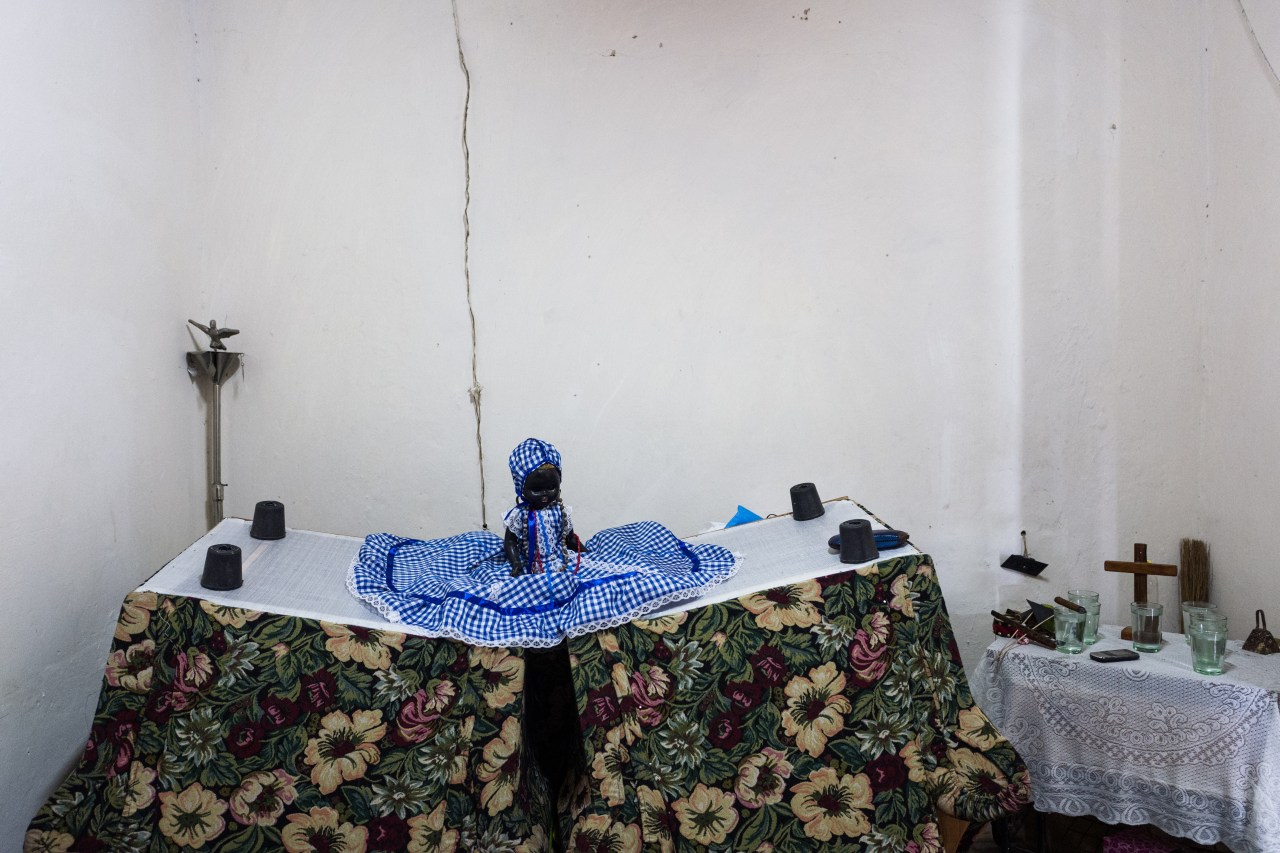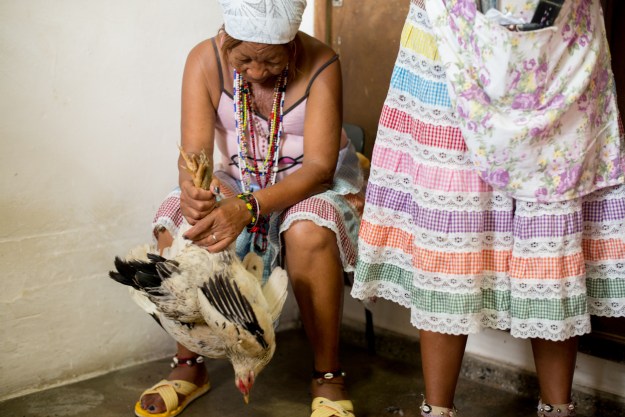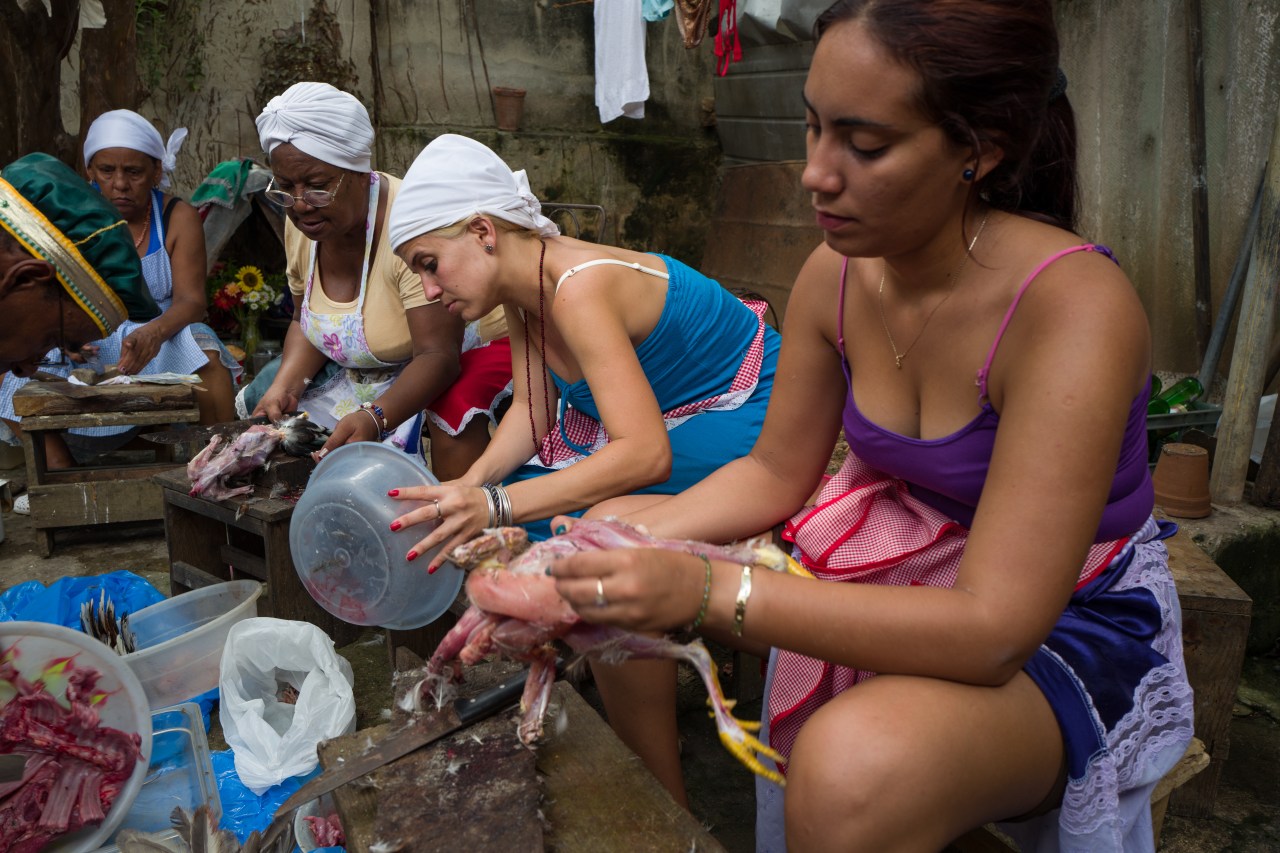Note: This article contains descriptions of animal sacrifice.
This is not Santería. Or at least this is not the Santería version you tend to get in Old Havana, where street hucksters wave a chicken around for tips. This is true arará, a spiritual practice born in the kingdom of Dahomey (now Benin), carried from West Africa to the West Indies by enslaved people, and locked up in prayer books and behind curtains for the better part of Cuban history. Cuban Santería, broadly defined, comprises two main groups. Lucumí is the largest and most public. Arará is the smaller, more secretive sect. And for a Cuba that seems to be lurching toward glasnost—with Wi-Fi in public parks and satellite dishes on every roof—that secretiveness is the appeal.
Bringing photographer Michael Magers, filmmaker Kate Kunath, and myself to this casa de santo in Pogolotti, a working-class neighborhood in the Marianao district, takes decades of connection to the island. An old bandmate of mine from when I lived in Cuba in 1999 is dating a woman who works for the Ministry of Culture. Let’s call her Yadira, to keep her from getting in trouble with the government she works for. I’ve gotten to know Yadira over the years. She’s smart, deeply funny, a little bawdy even. I never took her for the spiritual type. But when I go to Cuba in 2016, there she is in the living room of her Marianao apartment, dressed head to toe in the lacy white garb of an arará initiate. Propped by the front door is a small white parasol for protecting the top of her head when she walks outdoors. There are offerings in the kitchen: gourds, shots of rum, tobacco. And then there are the rules. She has a curfew. No more hanging out at the bar while her boyfriend sings with his band. No selfies with her—she can’t be in any pictures. Nor can I call her by her proper name. Particularly during that one-year initiation, she is vulnerable to evil spirits, and the rules are there to protect her. She tells me all this with a bit of a shoulder shrug and, as always, with jokes. “I’m like a baby, Nathan,” she says with a huge laugh. “A very big baby.”

Yadira’s priest lives in this casa de santo in Pogolotti. The priest has invited us to see parts of a multiday ceremony in honor of a young man just ahead of Yadira in his spiritual progress. He is marking the end of his yearlong initiation by sitting in isolation for a week, on a makeshift throne in a room behind a curtain in a corner of the house. He has to wear a sheet over his head just to walk to the bathroom down the hall. Otherwise he stays in his room, protected. On these, his last two days, the priest and a dozen helpers, including Yadira, are planning a crimson finale: an entire afternoon of live-animal sacrifice, spilling the blood over relics on the floor in front of his throne.
The house-temple is mid block, but walking from the main avenue, we sense it long before we actually get there. We look at our feet, and there on the sidewalk, amid the fallen poinciana leaves, is a clump of feathers. A few steps farther, there’s a torn wing. Farther still, the head of a chicken with a smudge of blood on the asphalt. These are territory markers, an eruv, the beginning of the blood.



In the street, a farmer pulls up in an old Chevy, an hour late. Live goats in the trunk; pheasants, roosters, and a turtle in the back seat. On the porch the animals lie tied up, bleating and fluttering their wings, waiting their turn. In the backyard men and women break down carcasses for meat and distribute their internal organs into buckets dedicated to various Orishas (the gods of Santería)—Eleggua, Obatala, Oggun, Yemaya. A decapitated rooster, there since the day before, lies flopped in front of an altar. And inside the house, in that corner room, the men perform a nonstop if slightly chaotic string of sacrifices throughout the afternoon. The chickens are easy. The goats take muscle to subdue and bleed out. The blood spills for hours.
I’ve been through nearly every kind of experience a visitor can have over the years in Cuba. I’ve drunk buckets of añejo with politicians, played charanga alongside famous musicians, been hustled in Old Havana, and arrested by the Foreign Ministry. In Cuba there is always, even in cruel moments, an ineluctable warmth. So when you see the blood spilled in this house, the deep and dark magic being summoned, keep in mind that they treat us three journalists from America—all of us pale and sweating and at times slightly overwhelmed by the viscera—like family. They hug us and feed us and tell us stories of their grandmothers, who left them books of incantations dating back to when slavery was legal on the island.
We leave before dark, witnesses to much but not to everything. For every curtain we are allowed behind, there is a chant we are not allowed to record. Every detail shared is matched by a secret that is still theirs. As it should be.
